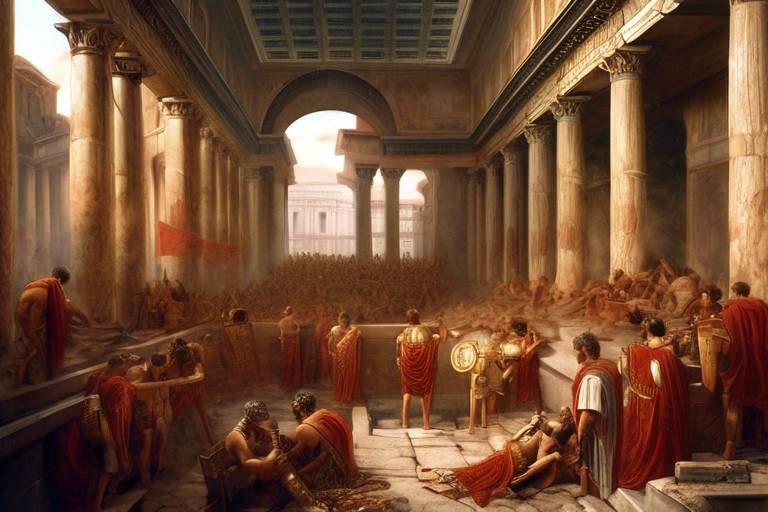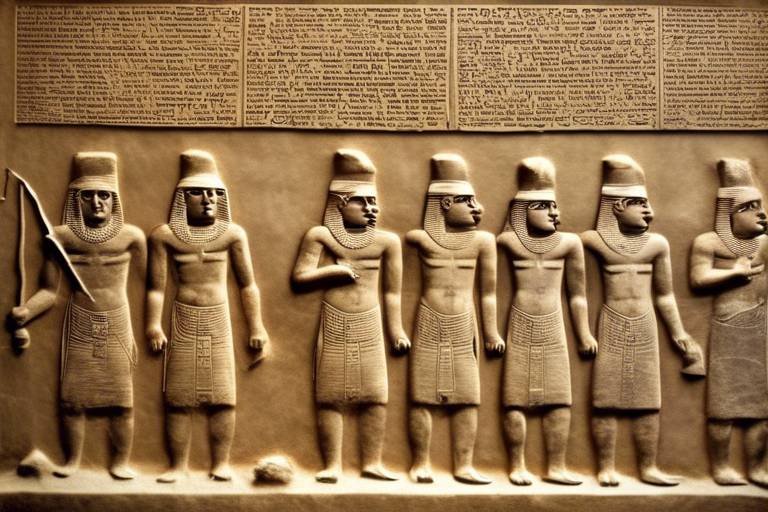The Cultural Significance of the Olmec Civilization
Exploring the ancient Olmec civilization reveals a rich tapestry of cultural significance that has resonated through the annals of Mesoamerican history. The Olmec people, often considered the "mother culture" of the region, left a lasting impact on art, society, and religious practices that reverberated across generations. Their monumental sculptures, intricate jade artifacts, and advanced societal structures stand as testaments to their ingenuity and creativity, setting the stage for future civilizations in the area.

Origins and Influence
The Olmec civilization, often referred to as the "Mother Culture" of Mesoamerica, holds a significant place in the annals of history for its profound origins and far-reaching influence. Emerging around 1400 BCE in the tropical lowlands of present-day Mexico, the Olmec people laid the foundation for future Mesoamerican cultures through their innovative practices and societal advancements. Their influence transcended time, shaping the artistic, religious, and social landscape of the region for centuries to come.
At the core of the Olmec civilization was a sophisticated agricultural system that supported their burgeoning population. By harnessing the fertile lands along the Gulf Coast, the Olmec developed advanced farming techniques, including the cultivation of maize, beans, and squash. This agricultural prowess not only sustained their society but also enabled the establishment of complex trade networks that connected distant regions, fostering cultural exchange and economic prosperity.
Archaeological evidence suggests that the Olmec were master builders, constructing monumental structures and urban centers that showcased their architectural ingenuity. The iconic colossal heads, massive stone sculptures depicting enigmatic human faces, stand as a testament to their artistic and engineering skills. These colossal heads, believed to represent revered leaders or deities, symbolize the Olmec's societal hierarchy and spiritual beliefs, leaving a lasting imprint on Mesoamerican art and iconography.
Furthermore, the Olmec's influence extended beyond the realm of art and architecture to encompass their religious beliefs and rituals. Central to Olmec spirituality were deities associated with nature, fertility, and the underworld, reflecting their close connection to the natural world. Elaborate rituals and ceremonies, often involving bloodletting and offerings, were performed to appease these deities and ensure the well-being of the community. The spiritual practices of the Olmec laid the groundwork for future Mesoamerican religions, influencing the mythologies and cosmologies of subsequent civilizations.
As pioneers of social organization, the Olmec established a hierarchical society governed by elite rulers and religious leaders. Their political institutions and systems of governance laid the groundwork for centralized authority and social stratification, shaping the dynamics of power and influence within their civilization. The Olmec's social structure not only facilitated cultural development but also set a precedent for future Mesoamerican societies in terms of leadership and governance.
In conclusion, the origins and influence of the Olmec civilization reverberate throughout Mesoamerican history, leaving a profound legacy that continues to captivate scholars and enthusiasts alike. From their innovative agricultural practices and architectural achievements to their artistic legacy and religious beliefs, the Olmec's imprint on the cultural tapestry of the region is undeniable. By unraveling the mysteries of this ancient civilization, we gain valuable insights into the complexities of Mesoamerican society and the enduring impact of the Olmec legacy.

Artistic Achievements
Exploring the ancient Olmec civilization's impact on Mesoamerican culture, art, and society. Unraveling the mysteries of their monumental sculptures, intricate jade artifacts, and advanced societal structures that influenced future civilizations in the region.
The Olmec civilization is renowned for its remarkable artistic achievements that have captivated historians and art enthusiasts alike. At the heart of their artistic legacy are the iconic colossal heads, massive stone sculptures that stand as a testament to their craftsmanship and creativity. These colossal heads, some weighing up to 40 tons, depict powerful individuals with distinct features, showcasing the Olmec's skill in sculpting stone.
Besides the colossal heads, the Olmec are also celebrated for their intricate jade carvings, which exhibit a high level of artistry and attention to detail. Jade, a precious stone highly valued by the Olmec, was intricately carved to create jewelry, figurines, and ceremonial objects. These jade artifacts not only demonstrate the Olmec's mastery of craftsmanship but also reflect the cultural significance of jade in their society.
Moreover, the Olmec artistic repertoire includes symbolic representations that provide insights into their beliefs and worldview. Symbols such as the jaguar, serpent, and maize deity are recurrent motifs in Olmec art, highlighting the importance of nature, spirituality, and agricultural fertility in their culture. Through these symbolic representations, the Olmec conveyed complex ideas and concepts that continue to intrigue scholars.
The cultural significance of Olmec art extends beyond aesthetics, influencing later Mesoamerican civilizations in terms of style, iconography, and artistic expression. The legacy of the Olmec artistic achievements endures as a testament to their cultural sophistication and creative ingenuity, leaving a lasting impact on the artistic traditions of the region.

Religious Beliefs and Rituals
The Olmec civilization had a rich tapestry of that played a central role in their society. At the core of Olmec spirituality were their various deities, which were often depicted in their art and monumental sculptures. These deities represented natural forces, animals, and celestial bodies, reflecting the Olmec's deep connection to the environment and the cosmos.
Central to Olmec religious practices were elaborate rituals that involved offerings, ceremonies, and sacrifices. These rituals were conducted in sacred spaces, such as temples and ceremonial centers, where priests and shamans performed intricate ceremonies to honor the gods and ensure the well-being of the community. The Olmec believed that these rituals were essential for maintaining harmony with the spiritual realm and ensuring the prosperity of their society.
One of the most iconic aspects of Olmec religious beliefs was the concept of cosmic duality, which emphasized the balance between opposing forces such as life and death, light and darkness, and order and chaos. This dualistic worldview permeated all aspects of Olmec culture, including their art, architecture, and social organization, reflecting their profound understanding of the interconnectedness of the universe.
Moreover, the Olmec practiced ancestor worship, honoring their deceased relatives and leaders through elaborate burial rituals and commemorative ceremonies. Ancestor veneration played a crucial role in Olmec society, as it reinforced familial ties, preserved cultural traditions, and ensured the continuity of leadership and knowledge within the community.
Overall, the religious beliefs and rituals of the Olmec civilization were integral to their cultural identity and societal cohesion. By exploring the spiritual worldview of the Olmec people, we gain a deeper understanding of the complexities of their civilization and the enduring legacy they have left for future generations.

Social Structure and Governance
The social structure and governance of the Olmec civilization were intricately intertwined, reflecting the hierarchical organization of their society. At the top of the social hierarchy were the rulers and elite class, who held significant power and influence over political decisions and religious practices. Beneath them were the artisans, farmers, and laborers who played vital roles in sustaining the civilization through their work in agriculture, craftsmanship, and construction.
Leadership roles within the Olmec society were often hereditary, passed down through noble lineages that held ancestral ties to divine beings. This system of governance reinforced the belief in the divine right of rulers and the importance of maintaining order and prosperity within the community. The rulers were not only political figures but also spiritual leaders responsible for mediating between the earthly realm and the supernatural forces believed to govern the universe.
The governance structure of the Olmec civilization also extended to the management of resources, trade relations, and defense strategies. Centralized authority figures oversaw the allocation of resources, distribution of goods, and coordination of trade networks that connected various regions within Mesoamerica. This centralized control facilitated economic prosperity and cultural exchange, strengthening the influence of the Olmec civilization throughout the region.
Moreover, the social structure of the Olmec society was characterized by distinct social classes that determined individuals' roles and responsibilities within the community. The division of labor based on social status ensured the efficient functioning of the civilization, with each member contributing to the collective well-being and advancement of the society as a whole. This stratified social system fostered a sense of unity and shared purpose among the Olmec people, reinforcing their cultural identity and sense of belonging.
In conclusion, the social structure and governance of the Olmec civilization played a pivotal role in shaping the cultural development and historical legacy of this ancient Mesoamerican society. Through their hierarchical organization, political institutions, and systems of leadership, the Olmec people established a foundation for subsequent civilizations in the region, leaving behind a lasting impact on the cultural landscape of Mesoamerica.

Technological Advancements
When it comes to technological advancements, the Olmec civilization was truly ahead of its time. Their innovative approach to agriculture revolutionized the way crops were cultivated in the region. By utilizing advanced techniques such as raised fields and irrigation systems, the Olmec were able to maximize crop yields and sustain their growing population.
Moreover, the Olmec excelled in architectural engineering, constructing impressive ceremonial centers and monumental structures that showcased their engineering prowess. The intricate design of their buildings, including the famous pyramids, reflected not only their technical skill but also their deep cultural and religious beliefs.
In the realm of pottery production, the Olmec were known for their sophisticated techniques and exquisite craftsmanship. They created intricate pottery vessels adorned with elaborate designs and symbolic motifs, showcasing their artistic ingenuity and attention to detail.
Additionally, the Olmec's mastery of jade carving was unparalleled in the region. They skillfully crafted intricate jade artifacts, including figurines, masks, and jewelry, demonstrating their expertise in working with this precious stone. These artifacts not only served as symbols of status and wealth but also as important religious and ceremonial objects.
Overall, the technological advancements of the Olmec civilization played a crucial role in shaping their cultural significance and influencing future Mesoamerican societies. Their innovative agricultural practices, architectural achievements, pottery production, and jade carving techniques all contributed to their legacy as pioneers of technological innovation in the ancient world.
Now, let's create the Frequently Asked Questions section as requested.
Trade and Exchange Networks
Trade and exchange networks were vital components of the Olmec civilization, facilitating connections with distant regions and enabling the flow of goods, ideas, and cultural practices. The Olmecs established extensive trade routes that stretched across Mesoamerica, allowing for the exchange of valuable resources such as jade, obsidian, and cacao.
These trade networks not only served as economic conduits but also played a crucial role in the dissemination of Olmec artistic styles and religious beliefs to neighboring societies. Through trade, the Olmecs were able to showcase their advanced craftsmanship and unique cultural expressions, influencing the artistic traditions of future civilizations in the region.
Moreover, the exchange of goods through these networks fostered diplomatic relationships and alliances, contributing to the socio-political stability of the Olmec civilization. By engaging in trade with neighboring communities, the Olmecs were able to forge connections that transcended geographical boundaries, fostering a sense of interconnectedness and mutual cooperation.
The trade and exchange networks of the Olmec civilization not only facilitated economic prosperity but also served as conduits for cultural diffusion and innovation. The interconnectedness fostered by these networks laid the foundation for the vibrant cultural exchange that characterized Mesoamerican societies for centuries to come.

Decline and Legacy
Exploring the decline of the Olmec civilization unveils a complex tapestry of factors that contributed to their eventual downfall. Environmental challenges, including soil depletion and climate change, are believed to have played a significant role in destabilizing Olmec society. As agricultural productivity declined, food scarcity and social unrest may have ensued, weakening the once-thriving civilization.
Additionally, internal conflicts and political upheavals within Olmec leadership structures could have further exacerbated the decline. The lack of a centralized authority or effective governance mechanisms may have led to power struggles and societal fragmentation, ultimately contributing to the civilization's unraveling.
Despite their decline, the legacy of the Olmec civilization endures through their profound influence on subsequent Mesoamerican cultures. The artistic achievements and cultural innovations of the Olmecs served as a foundation upon which future civilizations built, incorporating elements of Olmec art, religion, and societal structures into their own cultural fabric.
The Olmec legacy can be seen in the iconography and religious beliefs of later Mesoamerican civilizations, such as the Maya and Aztecs, who drew inspiration from Olmec artistic motifs and spiritual practices. The enduring impact of the Olmec civilization resonates through the centuries, shaping the cultural landscape of Mesoamerica long after their decline.
Frequently Asked Questions
- What is the significance of the Olmec civilization?
The Olmec civilization holds great significance in Mesoamerican history as one of the earliest and most influential cultures in the region. They laid the foundation for many aspects of Mesoamerican society, including art, religion, and governance, which influenced later civilizations like the Maya and Aztecs.
- What are some of the key artistic achievements of the Olmec civilization?
The Olmec civilization is renowned for its iconic colossal heads, intricate jade carvings, and symbolic representations in art. These artistic achievements not only showcase their advanced skills but also provide insights into their cultural beliefs and practices.
- How did the Olmec civilization contribute to technological advancements in Mesoamerica?
The Olmec civilization made significant contributions to technological advancements in Mesoamerica, including advanced agricultural techniques, architectural engineering, and pottery production. These innovations helped sustain their society and influence future developments in the region.
- What led to the decline of the Olmec civilization?
Several factors, such as environmental changes, internal conflicts, and possibly external invasions, are believed to have contributed to the decline of the Olmec civilization. Despite their decline, the Olmec legacy continued to influence subsequent Mesoamerican cultures.



















